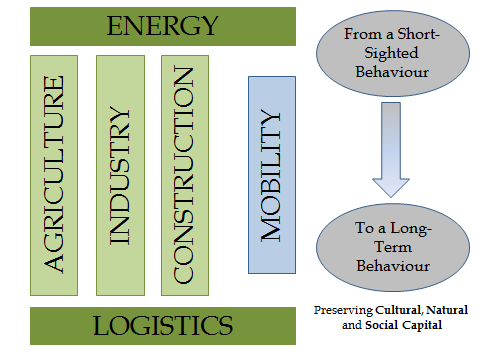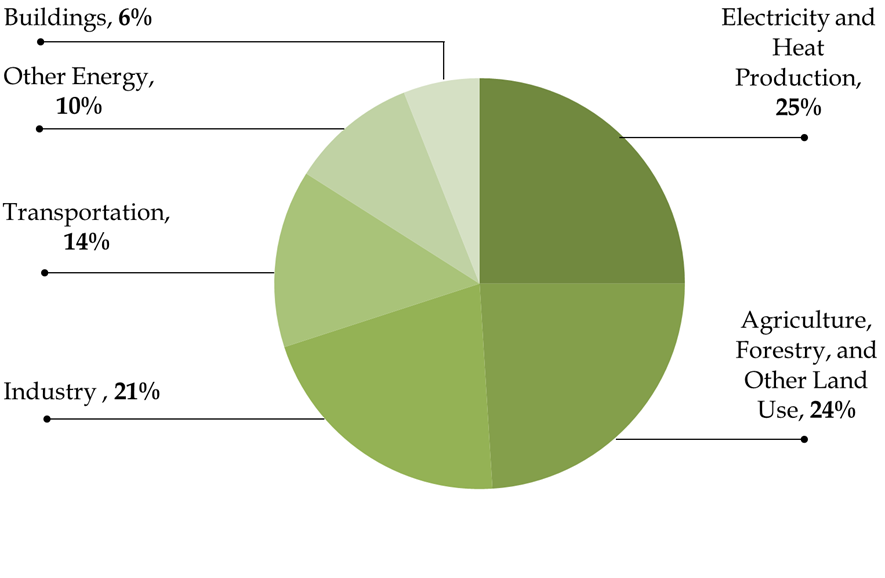Long Term Economy’s 6 Pillars
Long Term Economy is a new economic model. It aims at moving economic actors (whether institutions, companies or individuals) from a short-sighted behaviour (which is extremely detrimental to natural, social and cultural resources) to a long term one. Preserving local, natural, social and cultural resources guarantees economic well-being to all generations (present and future). Maximizing the current well-being without taking into account the effects on the future well-being is the most terrible act that we can do towards our children and our children’s children.
The implementation of the Long Term Economy acts on 6 pillars:
– The 3 sectors of production: Agriculture, Manufacturing, Construction.
– The 2 sectors which support the above 3 sectors: Logistics, Energy.
– Sustainability of urban centers: Mobility.
In order to reach the objectives of the Long Term Economy and preserve our planet’s resources, the 6 sectors will all have to move from a myopic perspective to a long term one.
Figure – Long Term Economy’s 6 Pillars

Source: Associazione Long Term Economy
The 3 sectors of production
According to the Intergovernmental Panel on Climate Change (IPCC) (2014), the 3 sectors of production (Agriculture, Manufacturing and Construction) account for 50% of greenhouse gas emissions; the remaining 50% is attributable to the Transport system and to the Energy system. More precisely, the agricultural sector generates 24% of emissions, industry 21% and the construction sector 6%. More generally, these three sectors have a strong ecological footprint due to their large consumption of resources and the vast production of waste for disposal.
Graph: Global Greenhouse Gas Emissions by Economic Sector

Source: IPCC (2014)
If firms operating in these three sectors become more farsighted (moving from a short term perspective to a long term one), they will drastically reduce their ecological footprint; their targets become:
1) surviving in a world characterized by resources constraints and where the demand for ecological production increases;
2) preserving the value of the community in which they are based.
So farms will no longer worry about their short-term yield, but they will preserve the quality of their soil and make their crops steady and resilient. Manufacturing companies will survive only if: 1) they create products that are ecologically sustainable and follow ecological procedures; 2) they don’t damage the cultural, natural and social resources of the country/community in which they operate. Construction companies will build eco-sustainable buildings and will no longer damage the natural capital of the territory.
Let’s see how these three sectors should be in order to respect the principles of Long Term Economy.
If Agriculture is to be sustainable,
it must be able to ‘produce food today and tomorrow’
1) Agriculture: the industrialization of agriculture (so the use of fertilizers, pesticides and machinery) has caused an increase in yields in the short term. But what about its long-term effects? What the effects on biodiversity and on soil quality? Unfortunately we are also experiencing a progressive loss of bio-diversity and a depletion of soil quality at a global level. If agriculture is to be sustainable, it must be able to ‘produce food today and tomorrow;’ this means to preserve soil quality. Sustainable agriculture must have a ‘low ecological footprint:’ it must use few external resources and produce low or zero CO2 emissions.
The Long Term Economy organization encourages, promotes and holds partnerships with all the people, companies and institutions that are engaged in the field of natural, synergistic and bio-diverse agriculture, as well as in Permaculture and in the conservation of native seeds and the agrarian culture of their community.
2) Manufacturing: the manufacturing industry uses about 35% of global electricity and is responsible for more than 20% of global greenhouse gas emissions, and more than a quarter of primary resource extraction. Manufacturing companies that will succeed in the future will be those that maximize ‘energy efficiency’ and ‘materials efficiency.’
– Energy efficiency: The margins of improvement in energy efficiency are high. On one end companies should make any efforts to eliminate energy waste; on the other hand they should start producing their own energy.
– Efficiency in the ‘use of the materials‘ (towards the circular economy): currently the waste of ingoing resources (raw materials) and outgoing resources (waste) in the production process is too high. The production-consumption cycle has to head towards the principles of circular economy (Kenneth E. Boulding) and bio-economy (Nicholas Georgescu-Roegen). The challenge is how to create business opportunities within closed production cycle.
The manufacturing of the future will produce the goods that contribute to the realization of the Long Term Economy. The Long Term Economy organization encourages, promotes and cooperates with all manufacturing companies engaged in the production of goods and adopting manufacturing processes coherent with the realization of the Long Term Economy.
3) Construction: sustainable building policies must address both new construction plans and the modernization of existing buildings.
– New construction plans: they must be designed so to avoid any further damage to cultural, social and natural capital. The techniques used for new buildings construction must be eco-sustainable and new buildings themselves must be environmentally friendly.
– Existing buildings these buildings must be modernized so as to be much more efficient.
The Long Term Economy organization encourages, promotes and collaborate with the construction companies involved in the realization of buildings with a low ecological footprint and which do not damage to the cultural, social and natural capital of territories.
The 2 Supporting Sectors
The role of logistics in the future goes far beyond
the economic greed of individual countries …
4) Logistics: in a sustainable society, each country and community should aim to minimize the dependence on external resources, following a Gandhian development model. That means enhancing a short supply chain with less needs for transportation.
However:
– Logistics is necessary: although countries and communities should reduce their dependence on external resources, the exchange of resources and finished goods between communities and between countries remains an essential element for ensuring widespread prosperity and stability in a world in which live 7 billion inhabitants. Logistics’ s long-term goal is to support, as efficiently as possible and with the minimal environmental impact, widespread prosperity around the planet.
– The role of logistics in the future goes far beyond the economic greed of individual countries: logistics can work as a guarantor of piece stability around the world. The loss of some essential resources in some countries/communities can cause wars and forced migration. Logistics can play a big role in these cases, by supplying those countries/communities with the necessary resources.
In order to get a really sustainable logistics system two key elements are necessary: 1) remove the organizational inefficiencies across the entire supply chain; 2) use eco-friendly vehicles and infrastructure.
– Remove the inefficiencies of the logistics system is the priority: today the logistics system has a lot of inefficiencies, primarily due to the lack of coordination throughout the supply chain; removing these inefficiencies would allow the sector to dramatically reduce its carbon footprint.
– Sustainable Infrastructure and vehicles for a sustainable logistics: obviously a sustainable logistics also requires low-carbon footprint vehicles to transport the goods from producers to consumers and from countries to countries. Some modes of transport (ships) (given the same amount of goods transported) produce less CO2 emissions than other vehicles (truck). A 360 degree action is required so as to minimize the ecological footprint of the freight movement.
The Association Long Term Economy encourages, promotes and collaborate with all logistics enterprises involved in the reduction of our environmental impact, and that follow the Long Term Economy’s principles; companies that don’t hurt, but contribute to the preservation and the development of the natural, social and cultural capital.
5) Energy: high levels of energy consumption (the highest in human history). This is what has allowed global population and the average well-being to grow so high and so fast over the past century. Thanks to the exploitation of fossil fuels the amount of energy available for human use has increased sharply over the past centuries. First coal and then oil were and continue to be the main sources of the energy system.
However, using fossil fuels to produce energy requires large investments and centralized systems. These systems are vulnerable and inefficient, as well as polluting. A sustainable energy system must be resilient (Countries and communities must not be dependent on others for most of the energy they need), resistant to cyber-attacks, thermodynamically efficient and non-polluting. This can only be achieved through a decentralized system of energy production, which uses mainly renewable resources (sun, water and wind), and makes the best use of existing information technology. A first step toward sustainability is the creation of local solar power plants, but the biggest step toward sustainability is to equip with buildings able to produce and share their own energy.
– The Winning firms: the companies that are to dominate in the future (in all sectors – productive or not) will be energetically self-sufficient; they will have a resilient, resistant and efficient energy system,.
– The importance of new technologies: according to Rifkin, a major revolution in the energy system is happening – innovation in the use of renewable resources are mixing with those in the field of information technology to give birth to what he calls ‘The Energy Internet.’ The new technologies will allow you to manage more efficiently the use and sharing of energy.
The Association Long Term Economy encourages, promotes and collaborate with all those companies involved in the development of a sustainable energy system.
Mobility
6) Mobility: More than 50% of the global population live in urban centres (and in some countries, like the United States the percentage is over 80%). According to a Report by the United Nations (Hot Cities: battle-ground for climate change), 70% of CO2 emissions come from urban centres.
Part of these emissions are due to a lack of inefficiencies in the management of urban mobility. Still too many people in urban centers take their car to get around. Sustainable urban mobility means allowing citizens to move easily and, at the same time, minimizing emissions of CO2 and of other polluting particles. This is possible by acting on two fields:
– Eliminating bottlenecks: making sure that more and more people use the public transportation system instead of take their own car. This can be achieved by increasing the punctuality, efficiency, coverage and cost effectiveness of the system.
– Zero-emission vehicles: creating environmentally friendly vehicles; hybrid or electric vehicles, whose sources of feeds use prevalently renewable sources.
Stefan Heck, co-founder and executive director of Nauto, in his book Resource Revolution argues that the car system should rely on Autonomous, Connected, Electrical, Shared vehicles.
The Association Long Term Economy encourages, promotes and holds partnerships with all companies involved in the realization of sustainable mobility.